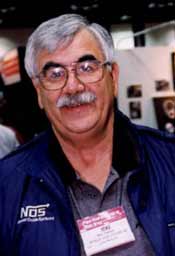|
By Guest Expert Mike Thermos
3/8/05
 |
Editor's
Note --
We’ve had a lot
of questions lately concerning how critical ignition
timing is when using nitrous in any motor. Rather
than answer a specific question we sent all of
them to our old friend Mike Thermos (Former owner
of NOS and current owner of Nitrous Supply) and
asked if he would answer the question in a general
manner. He agreed to and here is his in depth
answer concerning timing and nitrous.
|
|
 |
 Many
things can influence where the timing should be in a nitrous
engine. What you are actually trying to do is to get the engine's
peak cylinder pressure to occur sometime after top dead center.
Every engine is a little different, but some of the testing
we've seen on the dyno (set up with a pressure transducer
that measures cylinder pressure every tenth of a degree) suggests
about 14 to 15 degrees after top dead center (big block).
I've also seen some very small (1.8) motors with hi boost,
(over 40 psi with turbo and nitrous) run peak pressures at
about 20 degrees after top. This is all on racing gasoline. Many
things can influence where the timing should be in a nitrous
engine. What you are actually trying to do is to get the engine's
peak cylinder pressure to occur sometime after top dead center.
Every engine is a little different, but some of the testing
we've seen on the dyno (set up with a pressure transducer
that measures cylinder pressure every tenth of a degree) suggests
about 14 to 15 degrees after top dead center (big block).
I've also seen some very small (1.8) motors with hi boost,
(over 40 psi with turbo and nitrous) run peak pressures at
about 20 degrees after top. This is all on racing gasoline.
Look at it this way, the reason you start ignition before
top dead center is because it takes a certain amount of time
for that fuel to burn and create a maximum peak pressure.
The trick is to have this peak pressure occur at about 14
to 15 degrees after top. What happens when you add nitrous
oxide to your program is that you speed up the "burn
rate" of the fuel. You must back off on the ignition
advance or timing. This will actually give you more power,
because you've brought that pressure back to its "sweet
spot" where the peak pressure should occur.
A general rule is to back timing off two to two and a half
degrees for every fifty HP worth of nitrous added. Every motor
is a little different so you need to test. We've seen some
motors run with a total of 10 to 15 degrees of total timing.
Hope this helps,
Mike Thermos
mthermos@aol.com
 |
Fuel
for Thought [1/7/05]
Dave Koehler answers your nitrous & fuel-injection related questions |
|
 |
|

